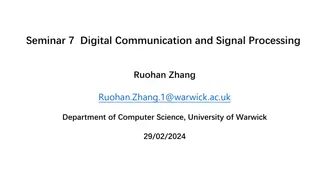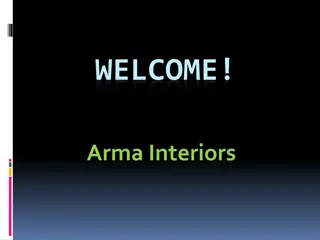
Understanding Arma: Types, Symptoms, and Treatment
Discover the ancient concept of Arma, a type of Netra roga, its classification into 5 types based on symptoms, such as growth characteristics and colors, and its treatment methods according to Ayurvedic principles. Learn about Lekhana Anjana Yogas, oral medicines, and Nasya yoga for managing Arma effectively.
Download Presentation

Please find below an Image/Link to download the presentation.
The content on the website is provided AS IS for your information and personal use only. It may not be sold, licensed, or shared on other websites without obtaining consent from the author. If you encounter any issues during the download, it is possible that the publisher has removed the file from their server.
You are allowed to download the files provided on this website for personal or commercial use, subject to the condition that they are used lawfully. All files are the property of their respective owners.
The content on the website is provided AS IS for your information and personal use only. It may not be sold, licensed, or shared on other websites without obtaining consent from the author.
E N D
Presentation Transcript
INTRODUCTION Arma is a Netra roga ,that comes under Shuklagata rogas. Term is derived from the sanskrit root with the meaning of regularly growing. According to Sushruta ,Arma is one among the Chedya rogas. Arma can be corrected with Pterygium in modern ophthalmology. 2
NIDANA 3
TYPES Arma are 5 types depending upon their signs and symptoms. 1. 2. 3. 4. 5. 6
1. ( . . .10) Soft,quick developing,painless growth of muscle. Bluish-red in color Caused by Tridosha with Rakta. 7
2. ( . . .10) Even,white and slowly growing muscle growth. Caused by Kapha dosha. 8
3. ( . . .10) Even and smooth muscle growth,resembling a lotus flower in colour. Caused by Rakta 9
4. ( . . .10) Thick and hard muscle growth ,appears like a brownish clotted blood. Caused by Tridosha 10
5. ( . . .10) Growth resembles Snayu in appearance. Caused by Tridosha 11
TREATMENT ( . . .11) Among 5 types of Arma ,that which is (thin), (turbid like smoke) , (reddish) , (resembles curd) are to be treated like Shukra. 12
Lekhana anjana yogas Kharparadi anjana, Krishnadi anjana, Pippalyadi gutikanjana, Pushpaakshadi rasakriya, Nayanasukha varti Lepana Marichadi lepa Oral medicines Shatavaryadi choorna, Mahatriphaladi ghrita, Lohadi guggulu, Shadanga guggulu, Brihat vasadi kwatha Nasya yoga Krishna lohadi yoga 13
Shastra Karma INDICATIONS ( . .15) Resembling , thick, fleshy growth covered densely with fibrous tissue That which is reaching krishnamandala ( . . .13) Shastra Karma should be avoided, if Arma is reached Drishtimandala. 14
Patient is made to lie in supine position. Do swedana of affected eye by Avagundana. Saindhava macerated with Beejapoora rasa is applied. Lids are closed and massaged briskly. Then the upper part of lid is held motionless. 16
If Arma is at Kaneenaka, patient is asked to look towards Apanga. The fold of arma is held with Badisha yantra and elevate it after tying with Suchi - Sutra. Then ,cut it with Mandalagra shastra, after leaving quarter of it - to avoid over flow of tears from tear ducts. If Arma is at Apanga, patient is asked to look towards Kaneenaka and rest of the process done accordingly. 18
After proper Chedana, do Pratisarana with Madhu,Vyosha and Saindhava. Do Parisheka with Sukhoshna Sarpi ,then Abhyanga with Madhu and Sarpi ,and bandaged. On the 3rd day, bandage is removed and eye washed with Ksheera boiled with Karanja beeja. On the 5th day, do Ashchotana with Kashaya prepared from Lodhra,Yashti,Nisha,etc. mixed with Madhu. On the 7th day,bandage should be removed. 19
- , , - , , , Diseases arising from and should be treated by proper Seka, Anjana, Lekhana and Brimhana treatments. 20
PTERYGIUM Pterygion a wing Pterygium is a wing-shaped fold of conjunctiva encroaching upon the cornea from either side within the interpalpebral fissure. Usually seen in old age. Usually present on nasal side but may also occur on temporal side. 21
ETIOLOGY Not definitely known. More common in people living in hot climates. Response to prolonged effect of environmental factors such as exposure to sunlight , dry heat , high wind and excess of dust. 22
SYMPTOMS Cosmetic intolerance Foreign body sensation and irritation Defective vision Restriction of ocular movements Diplopia 23
PARTS HEAD - Apical part ,present on the cornea NECK - Part present in the limbal area BODY - Scleral part,extending between limbus and canthus CAP - Semilunar whitish infiltrate ,present just infront of the head 24
TYPES 1.Progressive pterygium 2.Regressive pterygium 25
DIFFERENTIAL DIAGNOSIS Pterygium must be differentiated from pseudopterygium. Pseudopterygium is a fold of bulbar conjunctiva attached to the cornea. It is formed as a response to an acute inflammatory episode such as corneal trauma and marginal corneal ulcer. 26
TREATMENT Medical treatment of not much use. Tear substitutes - small regressive pterygium Topical steroids - for associated inflammation Protection from UV rays with sunglasses - to decrease the growth stimulus. 27
Surgical excision After topical anaesthesia, eye is cleansed, draped and exposed using universal eye speculum. Head of the pterygium is lifted and dissected it off. Main mass of pterygium is then separated. Pterygium tissue is then excised taking care not to damage the underlying medial rectus muscle. Haemostasis is done. Episcleral tissue exposed is cauterised thoroughly. 28
CONCLUSION In the initial stages ,Arma can be managed effectively by internal medications and Lekhana anjanas. In Arma , excision has to done before reaching the pupillary region. Post surgical precautions and medications are also useful to prevent recurrence. 31
REFERENCES Ashtangahridaya .Uttara.10 & 11 Ashtangasangraha.Uttara.13 Sushruta Samhita.Uttara.1 & 15 Comprehensive Ophthalmology - A K Khurana 32






















